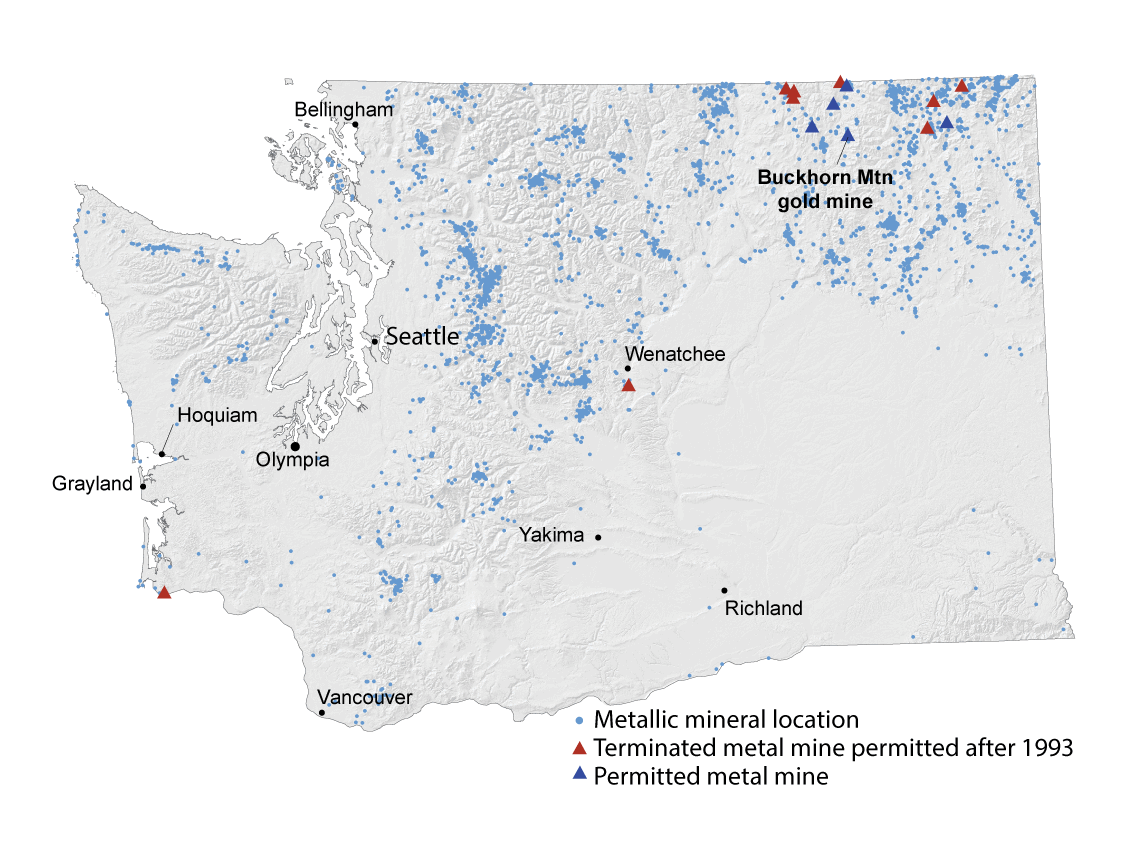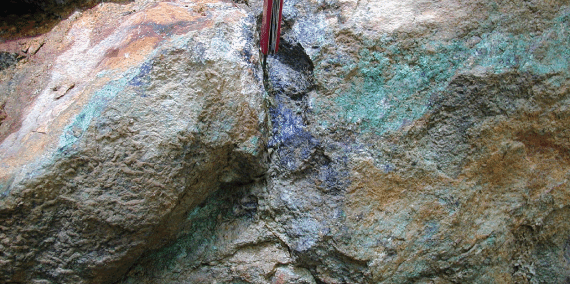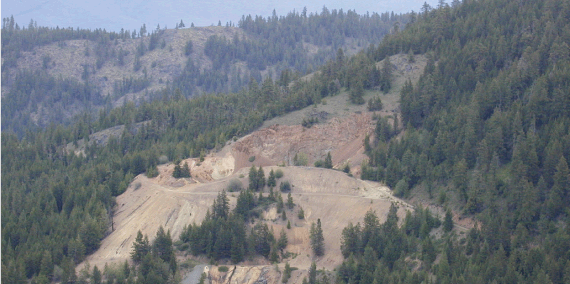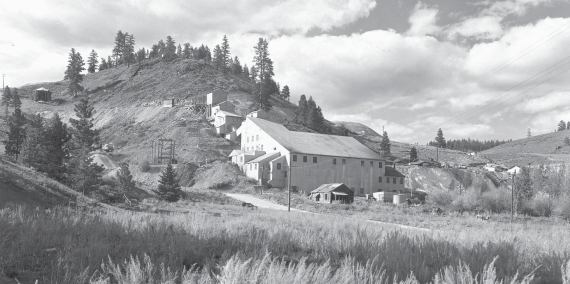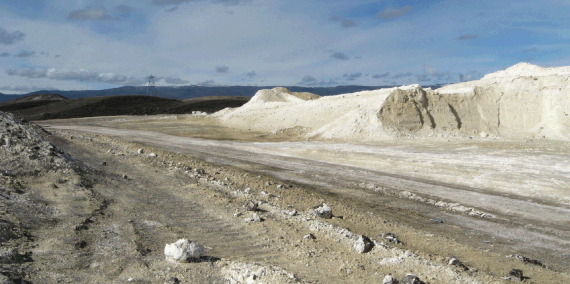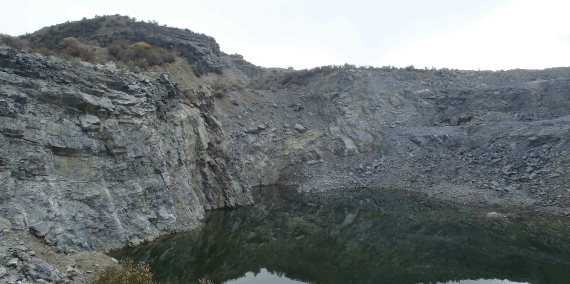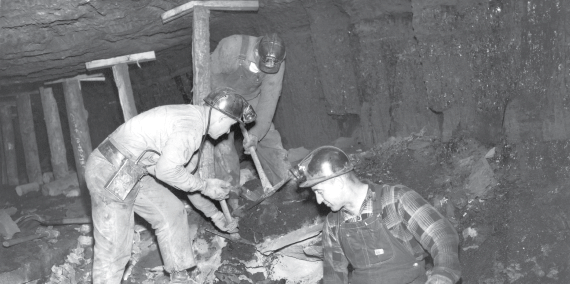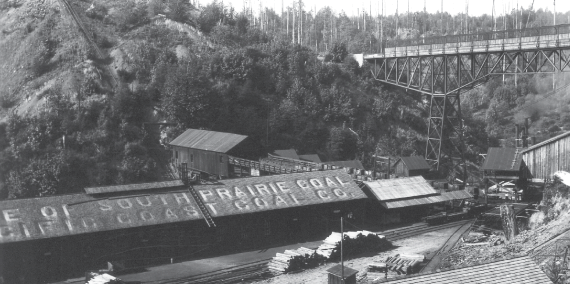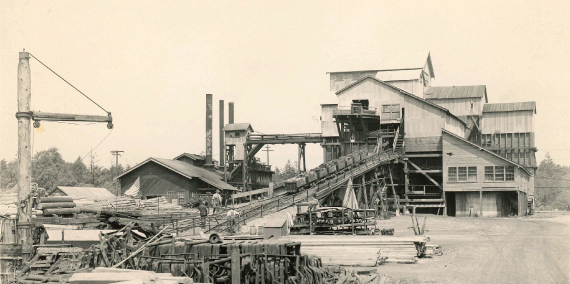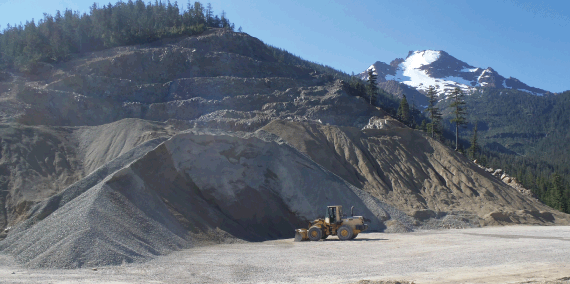
Mining of coal and metallic minerals in Washington began in the mid to late 1800s. Coal production in Washington hit a high in 2003 with an estimated total production of 6,232,000 short tons, yet production ceased in 2006. Metals mining during the same general time period occurred on both sides of the Cascade divide, but was largely concentrated in the northeastern portion of the state.
- Metallic Minerals
- Nonmetallic Minerals
- Coal
-
Metallic minerals are elements or compounds that are generally hard, shiny, malleable, and usually have good electrical and thermal conductivity and high density. These characteristics make them desirable for use in most of the products we use every day.
Ore deposits are metallic minerals in sufficient volume and concentration to be extracted economically. They are generally formed through one of three geological processes.
Magmatic ore deposits are concentrated within a body of igneous rock. Elements that were once widely dispersed in low concentrations in the magma become concentrated as they crystallize.
Hydrothermal ore deposits are formed where groundwater becomes super-heated. Such water can dissolve valuable elements throughout a large volume of rock. This element-enriched water is forced through cracks and fissures in the rock. As the water cools, it precipitates minerals on the surrounding rock.
Placer ore deposits are formed by flowing surface waters. The velocity of flowing water determines whether the minerals are carried in suspension or deposited. Minerals that are large or heavy such as gold will concentrate in areas where the water current slows.
Major Metallic Minerals in Washington
Metals historically mined in Washington include gold, silver, lead, zinc, mercury, uranium, and copper.
Mineral Appearance Uses Gold yellow, malleable, soft jewelry, currency, electronics, aircraft windows, medicine, electroplating Silver gray, malleable, soft, highly conductive jewelry, currency, solar panels, utensils, disinfectants, medical instruments Lead gray, malleable, dense, poorly conductive ammunition, batteries, radiation shields Zinc dull, silver-gray, hard, brittle, conductive anti-corrosive, batteries, alloys, wood preservative Mercury silver, liquid at room temperature Used extensively historically, but use has diminished after negative health effects from mercury exposure became more well known. Uranium silvery white, heavy, radioactive, isotopes highly fissile ammunition, vehicle armour, explosives, and nuclear power generation Copper orange, malleable, conductive wire and cable, construction, anti-microbial application Magnesium gray, lightweight, reactive, flammable aluminum alloys, die-casting, steel refinement, titanium production, aircraft, automobiles, electronics Aluminum silvery-white, ductile, lightweight, corrosion-resistant, chemically reactive alloys, aerospace, transportation, packaging, household items, pyrotechnics Newer mines have produced gold, lead, zinc, magnesium, and aluminum. Currently, Washington has several permitted metal mines, but only one of them is operational—the Buckhorn Mountain gold mine in Okanogan County, managed by Kinross Gold Corporation.
The mines shown are by no means all of the metallic mines in Washington. The remainder of the mines existed prior to the Metals Mining and Milling Act was signed.
Significant Mining Districts
Most of the major metal-mining districts in Washington were active in the early part of the 20th century and are now inactive. Most metal mining was concentrated in the north Cascade Range and in the Okanogan geologic province.
As part of an effort to identify hazards and environmental impacts of inactive mine lands, the Survey has published about 50 reports on abandoned mines. Most of these reports pertain to metal mines.
Inactive and Abandoned Mine Lands
Many of Washington's metal mines are now abandoned, and the Survey has steadily made headway in inventorying the history, physical characteristics, and geologic and environmental hazards of over 60 abandoned mine sites or districts. Only the mines with more than 2,000 feet of underground development, more than 10,000 tons of production, or had a known mill site or smelter have been evaluated at this point.

Click here to open the map in full screen.
Historic survey plats showing former mine locations are also available from the Bureau of Land Management. Master title/use plats provide information about oil, gas, mineral and geothermal activities, and can be accessed via a township and range search feature or by selecting from a list of categories. The resource provides records dating back to the mid-1800s.
Metals Mining and Milling Operations Act
The Metals Mining and Milling Operations Act (chapter 78.56 RCW), passed in 1994, established a regulatory scheme that is specific to metal mining. Mines included under the Metals Mining and Milling Operations Act are defined as operations mining base or precious metals and processing the ore by treatment or concentration in a milling facility.
Milling is defined as the process of grinding or crushing ore and extracting base or precious metals by chemical solution, electrowinning, or flotation processes. The Act includes new or expanding mines and mills, but excludes existing mines and mills.
DNR's responsibilities are carried out through the Washington Geological Survey. Metal mine reclamation is regulated through the Surface Mining Act (RCW 78.44, chapter 332-18 WAC)
Additional Information about Metallic Minerals
There are several ways to get more information about metallic minerals in Washington. A GIS-based data compilation of metallic minerals is available through direct download, or can be viewed through the Washington Geologic Information Portal. One of the main functions of the Survey in the early half of the 20th century was to inventory Washington mineral resources and report production. Because of this, we have published a lot of information about minerals over the years. Our Publications and Maps page provides several options for locating mineral-related information.
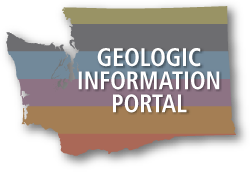


-
Geologists use the term 'Industrial Minerals' to describe nonmetallic minerals that have economic or industrial uses. Their characteristics and means of formation are highly variable. Historically industrial minerals have been mined statewide; however, most of the production has been on the east side of the state.
Major Nonmetallic Minerals in Washington
In Washington, the major nonmetallic minerals are diatomite, shale, silica, olivine (dunite), barite, and carbonates (limestone, dolomite and marble).
Commodity County Geology Uses Clay Cowlitz, Pierce, Pend Oreille, Spokane lake beds, altered volcanic rocks, and sedimentary rocks bricks Diatomite Grant sedimentary interbeds within the Columbia River Basalt Group pest control, abrasives, filtration, insulation, dynamite Silica King, Stevens sandstones, altered volcanic rocks, and quartzite glass, cement, fiberglass, sandblasting, filtering Olivine Whatcom Twin Sisters Dunite decorative stone, CO2 removal, aluminum casting, steel production Barite Stevens, Okanogan, Mason, Ferr, Pend Oreille precipitated from barium-rich hydrothermal solutions in fissure veins near granitic magma bodies drilling fluid additive, automobile finishes Limestone Okanogan, Stevens, Whatcom Metaline Formation, Spectacle Formation architecture, cement, aggregate, glass making, food, cosmetics, soil amendments Dolomite Okanogan, Stevens Cave Mountain Formation, Metaline Formation ornamental stone, aggregate, glass making, food, cosmetics, soil amendments, pottery glazes, float glass Shale King Illite- and kaolinite-bearing rocks of the Puget Group bricks Map of industrial mineral surface mines in Washington that were permitted through the Survey and locations where other nonmetallic minerals were reported.
Additional Information about Nonmetallic Minerals
There are several ways to get more information about nonmetallic minerals in Washington. A GIS-based data compilation of nonmetallic minerals is available through direct download, or can be viewed through the Washington Geologic Information Portal. One of the main functions of the Survey in the early half of the 20th century was to inventory Washington mineral resources and report production. Because of this, we have published a lot of information about minerals over the years. Our Publications and Maps page provides several options for locating mineral-related information.



-
Coal is a sedimentary rock that is composed mainly of carbon. Coal is formed through the metamorphism of peat over millions of years. Peat is formed in bogs and marshes from plant matter accumulated over thousands of years. As the peat is metamorphosed through high pressure, coal is formed in three distinct grades.
Lignite is the first to form and is commonly known as “brown coal.” Lignite is generally not considered a marketable grade of coal. Second to form is bituminous coal, which was the main type of coal mined in Washington. The highest grade of coal is called anthracite. Anthracite has the highest carbon content and lowest impurities of any of the coal grades, which give it the highest BTU output per ton.
Coal in Washington
Coal has been mined in Washington since 1853. Although production within the past few decades was from surface mines, nearly all coal produced prior to about 1970 came from underground workings. Since early in this century, Washington State law has required mine operators to submit detailed plans of all underground coal operations to the state on an annual basis.
There are currently no active coal mines in Washington State. The Centralia Coal Mine, in Lewis County, was once Washington's largest coal mine. Production came from five coal beds within the Skookumchuck Formation. It closed down production in 2006. The John Henry Mine, located in the Black Diamond Coal Field, produced about 250,000 tons per year during the mid-1990s and closed in 1997. Both the Centralia Coal Mine and the John Henry Mine are both undergoing reclamation at this time.
Map of major coal fields and reserve grade.
Historical Coal Mine Map Collection
The Washington Geological Survey hosts a large collection of digital versions of physical items and documents, including scanned thin sections (slices of rock mounted on slides), field notebooks, coal mine maps, and historical photos. Check out our coal mine map collection on our Data Preservation Website to learn more.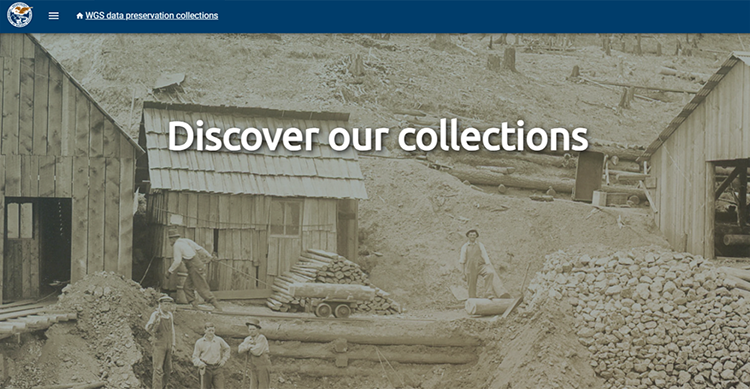
Additional Information about Coal
There are several ways to get more information about coal in Washington. A GIS-based data compilation of coal resources is available through direct download, or can be viewed through the Washington Geologic Information Portal. One of the main functions of the Survey in the early half of the 20th century was to inventory Washington coal resources and report production. Because of this, we have published a lot of information about coal over the years. Our Publications and Maps page provides several options for locating coal-related information.
Abandoned coal workings throughout the state are a potential hazard through subsidence or collapse. Some of these workings pose a risk to buildings or other structures. The Coal Mine Map Collection consists of a database and scanned historic maps of coal mine workings.




